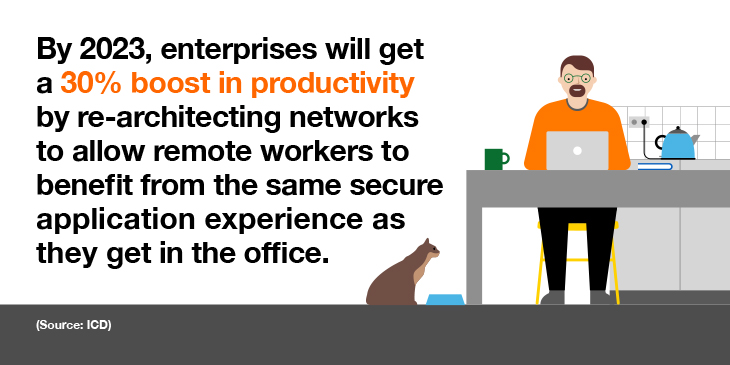As enterprises look to support user needs, it has become increasingly clear that legacy network architectures are not enough to handle a digital world dominated by mobility and cloud, according to IDC.
"This realization is causing a dramatic re-architecture of networks, built upon the principles of modern infrastructure components and a distributed, cloud-first architecture that can securely scale to meet the needs of modern digital businesses," explains Rohit Mehra, IDC Vice President, Network Infrastructure.
These changes will also impact the local area network (LAN). "Due to the external consequences of the pandemic, offices are transforming into flexible workspaces. LAN policies need to be dynamic and follow users in their different work locations," explains Massimiliano Brugnoli, Cybersecurity and Connectivity Sales Specialist for Southern Europe at Orange Business.
Invest in the LAN
Investment in the network is paramount for enterprises to exploit the opportunities of digital business, and this includes the LAN. By 2022, 40% of enhanced digital customer experiences will continue to fail because of underinvestment in intelligent, dynamic network architectures and technologies required for modern applications, according to IDC.
As Brugnoli points out, the LAN, including the wireless LAN, is "the visible connection between the user and their company and has an immediate impact on the user experience." As a result, the LAN environment needs to consider different users, such as guests and partners, and different devices, including BYOD and partner devices. At the same time, the LAN is evolving into a rich ecosystem, supporting IoT sensors collecting data in smart buildings to monitor air quality, for example, or proximity sensors to enforce social distancing.
According to Massimilano, the flexibility and speed of delivery required for new services are also shaping the LAN environment. "Traditional LAN requires a lot of day-to-day manual work, while the new LAN provides a lot of agility and better operational assurance with cloud-based controllers."
Enabling SDN in the LAN
Massimilano maintains that the new LAN will leverage AI for service assurance together with automation and analytics to reduce costs and downtime from an operational point of view. "All this is possible by enabling the software-defined network (SDN) paradigm where there is clear segmentation between the data plane, the management plane and the control plane," he explains.
The new LAN has abandoned the typical segmentation model where the IP address was used as a proxy to the user identity and to grant access to resources. Instead, the new LAN model leverages micro and macro segmentation according to the user and the device, regardless of their network location.
SD-LAN utilizes the key principles of SDN in the data center and SD-WAN to provide several benefits to wired and wireless local area networks. These include centralized management, application optimization, dynamic bandwidth sharing and cost efficiencies. This is all achieved while providing mission-critical business continuity to the network's access layer. Cloud-managed SD-LANs also benefit from reduced cost and complexity of network operations through centralized public or private networking.
No two enterprises are the same. To this end, Orange has built a multivendor approach to flexible LAN to help customers address their individual business needs. This can be deployed as a fully managed offering with full end-to-end management.
To help organizations tap into the benefits of SD-LAN, Orange has joined forces with Cisco to create a centrally-managed wired and wireless architecture that is easy to integrate and run. Leveraging the success of Orange Flexible SD-WAN, the project will ultimately create an end-to-end networking journey that delivers an optimized, adaptable enterprise network environment.
Business outcomes delivered by LAN transformation
There are several business benefits to LAN transformation. These include an improved user experience, notably through Wi-Fi 6, which offers higher throughput and lower latency. Wi-Fi 6 also offers better performance in congested areas, while service assurance reduces downtime and indirect costs.
LAN transformation also enables the seamless wired and wireless integration of users' services. This is something that was not possible with the traditional LAN without extensive customization effort. Central administration provides better controls, automaton, visibility, analytics and reporting. This allows incidents to be diagnosed and addressed faster, while supporting an enhanced security posture.
Future of connectedness
IDC maintains that many employees will either remain remote or operate under an office/remote hybrid post pandemic. This has implications for the network infrastructure. CIOs are realizing that changes will need to be made to engage a distributed workforce and ensure productivity.
IDC predicts that by 2023, enterprises will boost their productivity by 30% by re-architecting networks to include what it calls a "branch of one" operating model. This gives remote users the same secure application experience they get in the office.
Enterprises supporting a hybrid workforce will need to look at how LAN policies can be extended to optimize remote worker experiences. Key components will need to include a cloud platform for centralized management, centralized security and analytics to monitor performance and user experience.

Harvesting the potential of digital transformation
To harvest the potential that digital transformation promises, enterprises must not forget the importance of network agility in meeting the demands of business. The LAN is now the entry point into the overall IT infrastructure and a critical component in the connectivity puzzle.
LAN evolution, however, doesn't happen overnight. It requires careful planning and a transformation methodology that captures the way the enterprise wants to improve and translates these into use cases tested in a working environment before being rolled out across the enterprise once proven.
SD LAN could be key to helping you meet new ways of working. SD-LAN utilizes the key principles of SDN to offer up several benefits to office networks. This ebook looks at the benefits of SD-LAN, including centralized management, access management, adaptability, flexibility, dynamic bandwidth sharing, cost effectiveness and scalability.